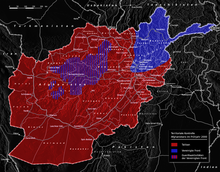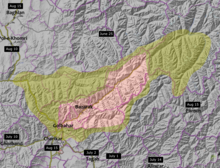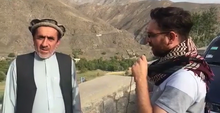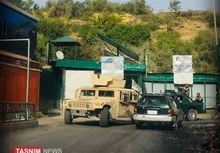Republican insurgency in Afghanistan
[65] Regardless, the former Islamic Republic of Afghanistan initially continued to exercise de facto control over the Panjshir Valley, which was described by The Week as "the only region out of [the] Taliban's hands" as of August 2021.[68] Prior to the fall of Kabul, Panjshiris began moving military equipment from surrounding areas, including helicopters and armored vehicles, into Panjshir Province.[75] Due to the rapid capitulation of the Afghan National Army, the Taliban have since acquired substantial materiel of US manufacture, including armored vehicles and combat aircraft.[73] Around 17 August 2021, remnants of the Afghan National Army began massing in the Panjshir Valley at the urging of Massoud,[66][78] along with local civilians who had responded to his mobilization calls.[93] A source within the Panjshir resistance consequently confirmed their involvement in the operations in Baghlan Province, and stated that they planned on seizing a northern highway which could allow them to link up with Tajikistan and Uzbekistan.[96] Meanwhile, resistance spokesman Ali Maisam Nazary informed the Agence France-Presse that Ahmad Massoud's group would prefer a peaceful resolution of the conflict, under the condition that a future government implemented a system of "decentralisation" and "equal rights" across the country.[119][1] Anti-Taliban sources claimed that the offensive involved al-Qaeda troops, a statement backed by videos in which pro-Taliban fighters were heard speaking non-native or locally uncommon languages such as Arabic.[1] A refugee interviewed later by Al Jazeera stated that the Taliban had blocked roads out of Panjshir using shipping containers during their offensive, and the shutdown of internet connections and mobile phone services left residents unable to learn what was happening in other places.[121] On 1 September, a day after clashes at the entry points of the valley were reported, Mullah Amir Khan Motaqi, the head of the Taliban's commission for guidance & encouragement stated over a Twitter audio message to the people of Panjshir that attempts at reaching a negotiated settlement were "unfortunately all in vain."[22] On 6 September, after heavy fighting resulting in high losses on both sides, the Taliban captured the governor's office in Bazarak, and claimed control of the whole Panjshir Valley.[140][138][141] By 7 September, many civilians from Panjshir Valley had fled into the mountains to escape the Taliban, while Massoud made defiant statements and called for a large-scale, nation-wide uprising.Taliban Cultural Commission member Anaamullah Samangani however claimed that the NRF had no "public presence" in Panjshir and were hiding in caves and valleys, with talks for their surrender ongoing.[121] Journalists of The New York Times allowed into Panjshir on 13 September reported that fighting had mostly ceased, as the Taliban controlled much of the valley and the NRF was apparently limited to the nearly inaccessible mountain areas.[160] By early November 2021, Jacob Zenn argued in Terrorism Monitor that there were no more militant forces loyal to Massoud operating in Afghanistan, while the NRF continued its efforts to reorganize an insurgency.The latter reportedly gained the upper hand with unknown casualties on both sides, thus confirming that the NRF is still active near Bazarak and in Panjshir despite claims of inactivity by local Taliban officials.The Independent reported that according to local sources a militia of 400 men took control of the mountainous area of Tondruk including 10 villages, located between the Hazrati Sultan District and the provincial capital of Aybak.According to the source, a few hours after the end of the clash, Taliban forces attacked the village of Kichi Mungar and killed two of Abdul Halim's relatives who were not associated with the militia.[178] By the end of January, local media claimed that NRF guerrillas were still operating and occasionally attacking Taliban groups in the provinces of Baghlan, Balkh, Badakhshan, and Faryab.[9] On 12 March, a new anti-Taliban insurgent and civil group, the Afghanistan Freedom Front (AFF), had emerged, after reports of its existence started circulating in early February 2022.As of early March, the AFF had already launched ambushes in Baghlan, Kapisa, Parwan, and Panjshir, with the Taliban reportedly using heavy weapons and air operations to suppress AFF-aligned resistance cells.[183] On 30 April, NRF forces led by Khari Mohammad Andarabi carried out attacks against Taliban bases in the villages of Taghanak and Paskundi in the Pul-e-Hesar district, in the Andharab region of Baghlan.[215] On 15 August, the one year anniversary since the fall of Afghanistan, the NRF launched an offensive in Panjshir, reportedly capturing seven villages in the Bazarak, Dara, Annaba, Shotul, Paryan, and Khenj districts, while surrounding Taliban fighters in several positions.The fighting reportedly started due to the Taliban launching a major military operation against AFF and NRF positions in the village of Henroh-Bala in Koklamy valley of Salang district in Parwan province.[278] On 22 November, 2024, the FDD's Long War Journal reported that General Yasin Zia and the Afghan Freedom Front had been taking a more prominent role in anti-Taliban resistance.[3] The former parliamentary representative of Samangan Province, Zia Arianjad reiterated the claim to the Iranian Aamaj News, stating that PAF was assisting the Taliban in Panjshir with drone strikes using smart bombs.[295] Shortly after the fall of Kabul, journalists Carlotta Gall and Adam Nossiter wrote in The New York Times that the international community would be in a bind if they showed some form of support for the resistance because of the airlift operations that were then ongoing.[30] Analysts Bill Roggio and Andrew Tobin speculated that the eventual success of the Taliban offensive against the Panjshir Valley in early September 2021 might have been related to the previous attempts of the NRF to expand into neighbouring districts.[302] The report noted that while the NRF and AFF are still too weak to hold territory, the Taliban has proven incapable of preventing guerilla attacks against them and also are unable to retaliate against the resistance.In the longer term, the resistance’s goal will be to control some districts outside Panjshir, ultimately building toward a larger base of operations to use against the Taliban similar to the Northern Alliance in the 1990s.The Hudson Institute analysis found that the NRF was also actively working to discourage international recognition of the Taliban as the legitimate government of Afghanistan, while pushing themselves as a credible alternative.










Panjshir offensives (Soviet–Afghan War)Afghan conflictPanjshirParwanBaghlanWardakDaykundiSamanganprovincesAfghanistanOngoinghit-and-runPanjshir ValleyIslamic Emirate of AfghanistanTalibanal-QaedaPakistanIslamic Republic of AfghanistanNational Resistance FrontAfghanistan Freedom FrontTajikistanHibatullah AkhundzadaMohammad YaqoobAbdul Ghani BaradarQari FasihuddinAbdul Qayyum ZakirAbdul Hameed KhurasaniAhmad MassoudAmrullah SalehBismillah KhanAhmad Zia MassoudYasin ZiaFahim DashtyHasib Qoway MarkazMehdi MujahidArmy of the Islamic Emirate of AfghanistanBadri 313 BattalionRed UnitMujahideenPakistan Armed ForcesPakistan Air ForceAfghan National Security ForcesAfghan National ArmyAfghan Air ForceSaur Revolution (1978)1979 uprisingsSoviet–Afghan War (1979–89)Afghan Civil War (1989–1992)Afghan Civil War (1992–1996)Afghan Civil War (1996–2001)War in Afghanistan (2001–2021)Afghanistan–Pakistan border skirmishesIslamic State–Taliban conflict (2015–present)low-levelguerrilla warvice president of Afghanistanpresident of AfghanistanceasefirePanjshir provinceBadakhshanFaryabSamangan Provincehit and runTaliban insurgency2021 Taliban offensiveNorthern AllianceHazarasHindu Kushinvasioncivil warwar of 1996–2001Ahmad Shah MassoudUnited States invasion of AfghanistanPashtunslightning offensivede factoThe WeekConstitution of AfghanistanMinister of DefenceBismillah Khan MohammadiDushanbeAmericanNational Resistance Front of Afghanistanfall of Kabularmored vehiclescommandosBaghlan ProvinceAndarab DistricthumveesSami SadatArmed Forces of the Islamic Emirate of AfghanistanUnited States Military Academyghost soldiersEmergencyParwan ProvinceCharikarSalang PassAndarabDih SalahPuli HisarJalalabadPajhwok Afghan NewsAbdullah AbdullahHamid KarzaiAli Maisam NazaryAgence France-PresseZabihullah MujahidAl ArabiyaDih Salah DistrictPul-e-HisarKhawak PassAl JazeeraWardak ProvinceDaikundi ProvinceKhadir DistrictBazarakThe TimesFacebookAhmed RashidBellingcatMohammad Zahir AghbarNational Congress PartyAbdul Latif PedramTOLO NewsAhmad Wali MassoudThe New York Times